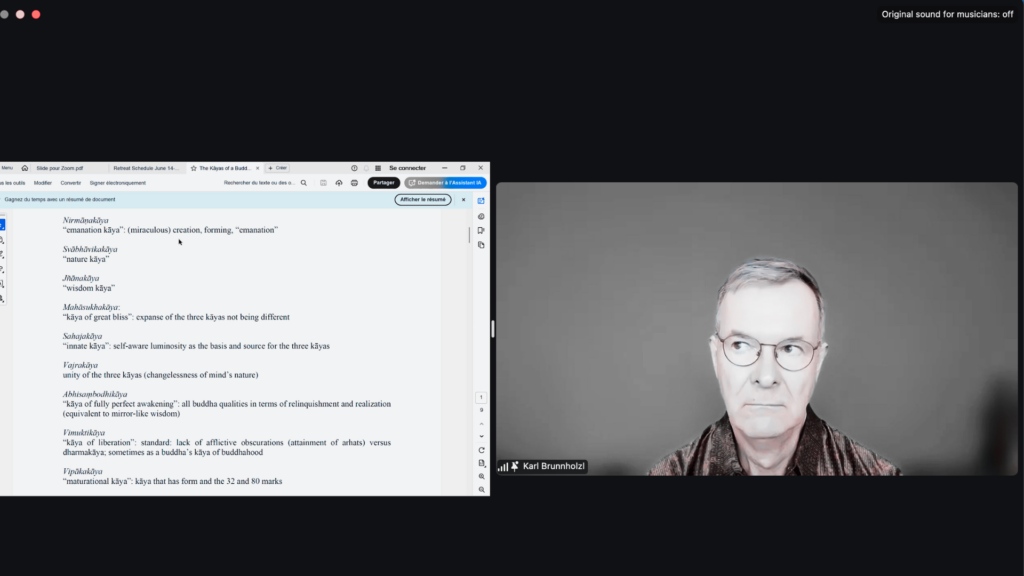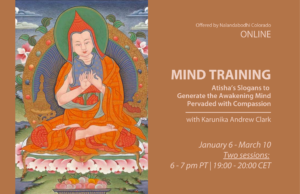The Kāyas of a Buddha: a weekend workshop with Mitra Karl Brunnhözl
We often hear references to the three or more kāyas of the Buddha, but what are they and where are they? Can we see them, can we experience them? How are we to understand these “bodies of enlightenment?”
Fortunately for all students of the Dharma, Mitra Karl Brunnhözl recently taught a weekend workshop that explored the universe of the kāyas as presented in the Sūtrayāna and Mahayana traditions, as well as in the Vajrayana texts, particularly Mahāmudrā and Dzogchen.
Characteristics and Functions of the Kāyas
Mitra Karl offered detailed explanations on the characteristics and functions of the three most frequently presented Kāyas (Dharmakāya, Sambhogakāya and Nirmaṇākāya) but also on other kāyas, which can sometimes represent the union of these three kāyas (such as Svābhāvikakāya in Mahāmudrā) or have a particular aspect in common, for example, the three kāyas of inner luminosity in Dzogchen (Vajrakāya, Abhisaṃbodhikāya and Dharmakāya).
Sūtrayāna and Vajrayana Perspectives
Explaining how the Sūtrayāna and Vajrayana perspectives differ regarding the three kāyas, Mitra Karl said that in the Sūtrayāna, the emphasis is on their manifestation for sentient beings, while in Vajrayana, they are seen as aspects of the nature of mind. He also clarified that the kāyas must be understood in a non-dual, non-conceptual way, and beyond notions of purity and self.
Incredible Practice Gathering
These profound and precious teachings were punctuated by chants of realization and contemplation. Mitra Karl accompanied some of the chants on guitar, much to the delight of the participants. The atmosphere was relaxed and conducive to reflection, and although the presentation was online, it felt as if we were warmly gathered together.
To conclude the workshop, Mitra Karl answered many questions from participants, including several regarding practice (on the cushion and post-meditation). What an incredible weekend for these fortunate dharma students and practitioners!
Written by Claire Lecompte, Emcee during this online workshop of Nalandabodhi Montréal with Mitra Karl Brunnhölzl
Les Kāyas d’un Bouddha : une fin de semaine avec Mitra Karl Brunnhözl
Avec cet atelier nous avons exploré l’univers des kayas tels que présentés dans les traditions Sūtrayāna et Mahayana, ainsi que dans les textes du Vajrayana, en particulier du Mahāmudrā et du Dzogchen. Mitra Karl a offert des explications détaillées sur les caractéristiques et fonctions des trois Kayas les plus souvent présentés (Dharmakāya, Sambhogakāya et Nirmaṇākāya) mais aussi sur d’autres kāyas, lesquels peuvent parfois représenter l’union de ces trois kāyas (tel Svābhāvikakāya dans le Mahāmudrā) ou avoir un aspect particulier en commun, par exemple, les 3 kāyas de la luminosité intérieure dans le Dzogchen (Vajrakāya, Abhisaṃbodhikāya et Dharmakāya).
Mitra Karl nous a expliqué comment, en ce qui concerne les 3 kayas, les perspectives Sūtrayāna et Vajrayana diffèrent puisque, dans le Sūtrayāna, l’accent est mis sur leur manifestation pour les êtres sensibles tandis que dans le Vajrayana ils sont vus comme des aspects de la nature de l’esprit. Mitra Karl a clarifié que les kayas doivent être compris de façon non duelle, non-conceptuelle, et au-delà des notions de pureté et du soi.
Ces profonds et précieux enseignements ont été ponctués de chants de réalisation et de contemplations. Mitra Karl a accompagné certains chants à la guitare, pour le plus grand plaisir des participants. L’atmosphère était détendue et propice à la réflexion et bien que la présentation soit en ligne, c’est comme si nous étions chaleureusement rassemblés. Mitra Karl a répondu aux nombreuses questions des participants, dont plusieurs concernant la pratique (sur le coussin et post-méditation). Quel incroyable week-end pour ces chanceux étudiants et pratiquants du dharma!
Écrit par Claire Lecompte, animatrice lors de cet atelier en ligne de Nalandabodhi Montréal avec Mitra Karl Brunnhölzl






